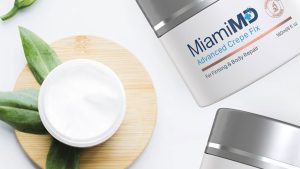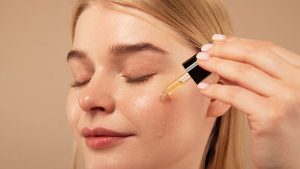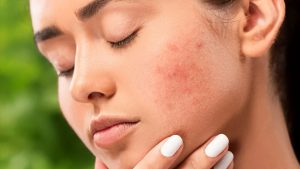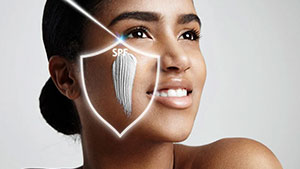Senescence: What Is It and What Does It Mean?

Senescence is a word you may not have heard before, but it is something that impacts all of us at some point in our lives. Although it often gets confused with the standard aging process, senescence is more about how our cells naturally deteriorate as we age.
At MiamiMD, we are always looking for more ways to understand what happens as we get older. That knowledge helps us create products to hold the visible signs of aging off for as long as possible. With that in mind, let us take you on a deep dive into cellular senescence and what it may mean for you.
What Exactly Is Senescence?
To understand senescence, let’s start by talking about how it differs from what we consider “aging.”
Aging, and the process of aging, is a part of the life cycle of any living creature. No matter what we do, how healthy we eat, or what skincare products we use, the aging process happens to everyone. How fast it happens is ultimately the result of a combination of time, genetics, and certain environmental factors.
As we get older, those factors start to bear more weight, leading to a breakdown of the physical body.
While that may sound grim, it’s just a description of the aging process that happens to all of us, as well as a reminder to enjoy life every single moment! Whether we want to think about it or not, life is a one-way trip.
While senescence is related to aging, it varies slightly. Aging refers to a whole-body approach, but senescence refers to the biological aging process that happens specifically to our cells. It is irreversible and caused by stress or damage from outside and inside the live cell (known as in vivo). Senescence can happen to any cell inside the whole organism that is the body, from epithelial cells to muscle tissue to endothelial cells.
However, senescence can work in our favor, as it is usually a protective response the body uses to stop “bad” cells from growing out of control. It is just one stop along the normal cycle our cells go through, but one with a lot of importance — especially when it comes to our skin!
Let’s Look at Senescence at Work
Senescence is a complex state that results in a cell’s inability to divide. If you remember much about your high school biology class, cell division is crucial because it is how cells reproduce, repair themselves, and grow.
When a cell becomes senescent, it stops responding to growth factors produced by the body to tell it to grow, leaving it susceptible to damage and even cell death via irreversible growth arrest. However, senescent cells also stay metabolically active, so they are still “alive.”
When a cell is senescent, certain features (known as biomarkers) can identify them:
-Cell cycle arrest – Senescent cells can’t be triggered into going through the cell reproductive cycle.
-Changes to morphology and metabolic state – Unlike “normal” cells, senescent cells appear larger and flatter.
-Chromatin reorganization – DNA, proteins, and other genetic material may be reorganized inside the cell.
-Altered gene expression – Senescent cells may have specific proteins switched on or off, changing the activity of the cell.
SASP helps them communicate with other cells and the immune system, allowing them to tell those cells (namely tumor cells) what to do.
But senescence isn’t all bad. In some instances, senescent cells can actually prevent the expansion of malignant and damaged cells. It may also help with wound healing!
When either of those situations happens, they are so effective that researchers continue to look into how to harness that power to help keep our bodies more healthy than ever.
Why Does Senescence Happen?
Unlike aging, senescence isn’t something that happens in a scheduled time frame. While the signs of senescence tend to go hand in hand with the natural aging process, this is primarily because we collect more senescent cells as we age. With more of those cells in the body, it’s more likely to see their effects as well.
So what causes a cell to go into senescence?
There are five main reasons it happens:
-Telomere shortening – Some cells stop dividing after going through a set number of cycles. Every time those cells finish a reproductive cycle, the telomeres (the end of chromosomes, like DNA) get just a little bit shorter. Eventually, they are too short to continue dividing any further.
-DNA damage – When DNA damage happens, cells respond by doing one of three things — working on DNA repair, triggering cell death (known as apoptosis), or becoming senescent. If that damage continues to happen (we’ll discuss how it happens in a moment), the likelihood of senescence increases.
-Epigenetics – Our normal aging process.
-Mitochondrial dysfunction – All cells contain mitochondria, which produce energy. If cells are experiencing mitochondrial dysfunction, they can’t make the energy the rest of the body needs to survive.
Each of these leads to the cell being tagged with senescence markers, making it a target for a senescent state.
How Does Senescence Impact Our Skin?
We know that senescence can impact any cell, but how does it specifically affect the skin?
Our skin cells (keratinocytes and fibroblasts) move through the normal cell life cycle like all other cells. That means, at any stage of the game, they can be subject to becoming senescent.
Let’s look more closely at fibroblasts, the most common type of cell found in our connective tissue (these are the cells that make our all-important, youth-boosting collagen and elastin — the extracellular matrix).
When they are young and healthy, fibroblasts are often described as spindle-shaped and flat. When they enter into senescence, they lose that tell-tale spindle and become even more elongated and flat. They may be “working,” but they can’t produce collagen to keep the skin plump and firm.
Senolytics
One of the ways that researchers are working on understanding and treating senescence is through senolytics.
Senolytics are a specific class of drug that has been developed to help with the clearance of senescent cells from the body selectively.
As we’ve learned, not every senescent cell is “bad.” Some of them may actually work as protective cells in the body, keeping us safe from harmful bacteria. Senolytic drugs target the “bad” cells, leaving behind the “good” ones.
While this science is still in its infancy, it has plenty of potential, and therapies that include it continue to grow.
Other Ways To Help Counteract The Side Effects Of Senescence
As senolytic drugs haven’t been developed to target the skin specifically, it’s essential to know how to keep it as healthy as possible. That way, you can counteract the side effects of senescence using a whole-body approach to regulation.
Everything relating to the aging process is “irreversible,” but it can be stopped or slowed down along with age-related pathologies (at least temporarily). The same goes for senescence.
Here are a few ways to keep your skin looking and feeling its best, even as you age.
Reduce Your Oxidative Stress Level
One of the factors that may increase the likelihood of your skin cells entering senescence is oxidative stress.
Free radicals aren’t foreign bodies, though. The body produces them in response to the damage done by environmental toxins (like tobacco smoke or pollutants) or chronic sun exposure (ultraviolet radiation). Unfortunately, free radicals are very unstable, as they lack an electron, making them off balance.
Free radicals bounce around the body to find their missing electron, often stealing electrons from other, stable molecules.
The vast amount of premature aging can be traced back to free radicals and oxidative stress (including fine lines, wrinkles, dark spots, sagging skin, etc.). But we can’t avoid the sun entirely or many other environmental factors that come into play. So what do we do?
You can start by always wearing sunscreen when you leave the house — every single time. By helping to protect yourself from the ultraviolet radiation emitted by the sun, you are also lowering your risk of oxidative stress and all the things that come with it.
You’ll also want to include more antioxidants in your skincare, like vitamin C, which has been proven to help reduce oxidative stress. Antioxidants are a natural counter to free radicals, as they bind themselves to them and share their electrons, assisting in eliminating free radicals.
Antioxidants are helpful from both the inside and the outside, as you can apply many of them topically and focus on eating a healthy diet full of vitamin C-rich fruits and vegetables, like kale, cherries, and strawberries. They may also reduce redness and swelling, support the immune system, and fight off the DNA damage response mounted by the body’s reaction to free radicals.
Deal With The Symptoms As They Occur
You also don’t have to sit back and let the symptoms of senescence take over. If you’ve noticed the signs of cellular aging, like fine lines, wrinkles, and hyperpigmentation (dark spots), fight back.
Miami MD’s Dark Spot Corrector is a great tool to have at your disposal for this very reason. We specifically formulated it to help erase dark spots so that you can slowly reveal a more youthful, even skin tone.
With ingredients like Alpha-Arbutin, which helps inhibit tyrosinase from blocking the overproduction of pigment, and antioxidants like vitamin C and Resveratrol to brighten and fight off the symptoms of oxidative stress, you can’t go wrong.
Kojic and glycolic acid also help exfoliate the skin and sweep away the dead skin cells, leaving you looking fresh and radiant. If it’s fine lines and wrinkles that are getting you down, we have a product for that too!
Our Instant Wrinkle Eraser helps to make them practically invisible.
The fast-acting solution, made with ingredients like Matrixyl Synthe-6 and Acetyl Hexapeptide 30, works to help reduce their appearance and boosts your self-confidence. It’s a great way to get at-home results without needing to head to the dermatologist for uncomfortable, costly injections.
Drink Plenty Of Water And Eat A Healthy Diet
Although we all logically know the importance of drinking enough water and eating a healthy diet, few are good at it in practice. However, putting more focus on giving your body what it needs to run smoothly is yet another way that you can potentially hold back senescence by supporting your immune cells.
For instance, the human body is made up of 60% water on average. Nearly every function our body performs requires water, so not giving it what it needs can significantly impact every other system in the body.
Focusing on drinking at least eight glasses of water a day can help you pull your skin back from dehydration, which can also make it more radiant and youthful-looking. If you haven’t had any yet today, this is your sign.
But it doesn’t stop there. Diet is also crucial to keeping your body both looking good and operating at its optimal level. Instead of consuming preservatives, unhealthy carbs, and added sugar, focus more on whole foods like fruits and vegetables. Not only are they packed with antioxidants, but they’re also great at helping you maintain a healthy weight.
To Summarize
Understanding what senescence is can help you find the best products to help reduce its potential impact on your appearance.
While we are all subject to the aging process, senescence is more flexible. You don’t have to let the speed at the senescence response happen to be up to fate.
If you’re not ready to give up and give in, fight back with the functional beauty products we’ve created here at Miami MD as well as the other tips we’ve offered.
You’re in control of your body, and it’s time you took your power back.
Sources:
Senescence and aging: Causes, consequences, and therapeutic avenues | NIH
Fibroblast | National Human Genome Research Institute
Protective effect of vitamin C on oxidative stress: a randomized controlled trial | NIH





